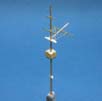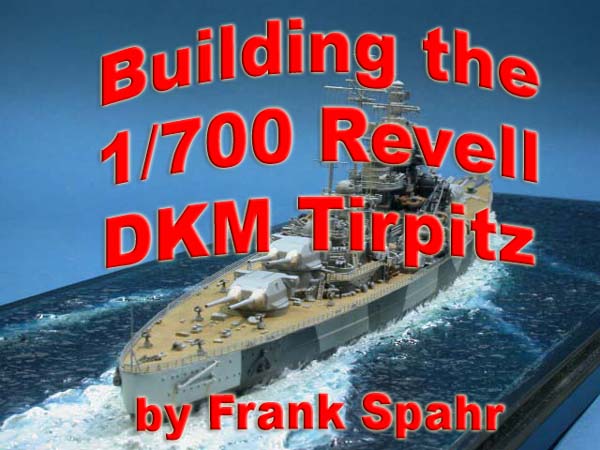| The Subject |
|
| There´s little need for me at this point to say much
about this famous vessel. She was Germany´s last battleship, sister
to Bismarck, and spent virtually all of her career in Norway being a threat
to allied supplies. Her mere presence necessitated heavy units escorting
the Murmansk convoys, and both sides went to great lengths in protecting
and trying to destroy her. Finally on 12 November, 1944, after a series
of unsuccessful attempts, ultra heavy „Tallboy“ RAF bombs destroyed her
at her mooring, killing about 1,200 of her crew. |
| The Kit |
|
Revell has produced the currently best 1:350 versions of
Bismarck and Tirpitz some years ago. In smaller scale, the company range
only had Bismarck and Tirpitz as hopelessly outdated box scale versions.
Hence, 1:700 kits of both Bismarck and Tirpitz were produced using the
data collected for the larger versions. Given the availability of the recent
Dragon and Trumpeter offerings, the reception these kits had was on the
lukewarm side, even more so as no implicit waterline option was included
and the smaller AA guns were regarded as clunky.
I for one did understand the company´s need to offer a current
kit of these economically important subjects. I also understand that they
do not primarily target us enthusiasts as their audience, but a rather
broader target group including people building just for fun and without
any severe commitment. Having read enough disappointed comments on the
kit, I decided to build one myself to see how it actually was. |
| Building the Kit |
|
| I decided to build mine waterline, and to place it in a Trumpeter display
box. Even in 1:700, it´s a rather large vessel, and the biggest display
box was needed. I committed my biggest mistake right in the beginning while
waterlining, the hull, as in not cutting away enough of it. I should have
removed another two millimetres, as it is my ship rides a bit high in the
water. |
 |
| My current explanation (read this as lame excuse) is that she´s
sailing towards a shallow area en route to a new anchorage, so her bunkers
are empty and her draught minimized. This goof doesn´t speak against
the kit, rather against my commitment in attacking it with tools. |
 |
|
|
| I had received the dedicated PE set for the kit, which is produced
by Eduard for Revell, but had also bought the WEM PE set, which has finer
parts, but is designed for the Dragon kit. In the end, it was a mix and
match of parts, with the Eduard railings being used as they were customized
for the kit. A lot of other items were taken from the WEM offering. |
 |
| Apart from the PE, the masts were replaced by BMK tapered brass stock
for stability. BMK and Master provided brass barrels for the artillery
down to the 105 mm heavy flak. The lighter calibres were retained as kit
parts, partly because I didn´t regard them as that bad and partly
because I didn´t prefer fiddly and two-dimensional PE replacements.
The model was built in suabassemblies and painted with acrylics, using
the camo schemes from the excellent web resource www.bismarck-class.dk
The model was otherwise built OOB, without serious soul-searching on the
accuracy of sensor or AA or boat fit for the period depicted with the camo
scheme selected. |
 |
| The wooden decks were painted tan and then washed brown, I did quite
like the effect. Only a little weathering was applied below the anchors,
as Tirpitz´ crew had a lot of time to keep her spick and span or
to repaint her in some fresh scheme. |
 |
| The model was manned with Lion Roar PE figures and rigged with tan
stretched sprue for the signal lines and UNI flyfishing thred (8/0 and
Caenis) for the rest. Once complete, a final flat coat sealed the model
and blended things in. |
 |
| The base was prepared as usual with me; it was sculpted with generic
plastic putty, the overall texture applied with wall paint, the base was
sprayed with green and blue acrylics, and sealed with solvent-based clear
gloss spray. Any gaps between the model and the seascape were sealed with
clear gloss acrylic gel, and highlights were applied with white artist´s
oil paint. |
 |
| All in all, this was a fast and enjoyable project. It´s not my
usual subject, and I don´t feel that much enthusiasm for the Kriegsmarine.
Hence I wasn´t hampered by too much of an effort to get as much as
possible right, but could just build for fun. I did like the one-piece
deck, the overall nice details, esepcially around the funnel, and the good
fit. I did not like Revell´s pretty unusual design for the inclined
ladders, though. These unloved „aztec stairs“ are molded with the upper
deck and have extensions that fit into a hole in the lower deck. |
 |
| That makes removing them more laborious than usual, as you need to
somehow fill the missing area in the scribed lower deck. The Eduard PE
does nothing to rectify the situation, but only offers handrails for the
offending aztec stairs. So I had to source my inclined ladders from WEM
and Lion Roar. |
 |
| On the whole, this kit is excellent value for money. Its
downsides are:
- Lack of waterline option ( a molded-in mark on the inside of the hull
would be nice)
- Unnecessarily complicated design of inclined ladders
- Due to a very small box, the instructions are printed in a very cramped
style and hard to read
On the other hand, it offers:
- Crisply molded parts
- A high detail level oriented on the design of the larger version
- An easy to work with one-piece deck
- Excellent and comprehensive decals
Even built OOB, it should build into a good representation of the last
German battleship, and of a ship many consider one of the best-looking
battleships around. |
|
|


